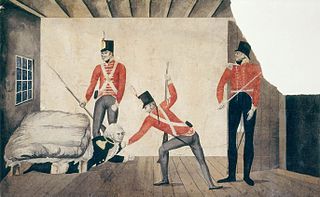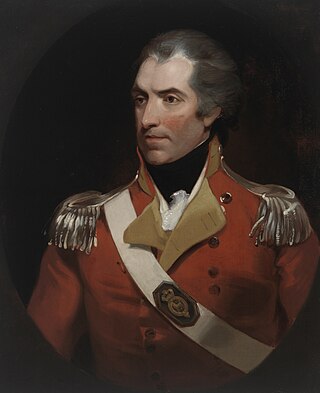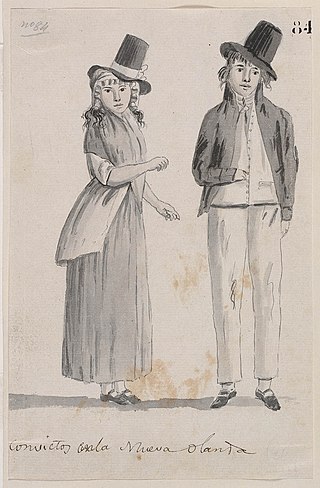This article needs additional citations for verification .(February 2024) |
| |||||
| Decades: | |||||
|---|---|---|---|---|---|
| See also: | |||||
The following lists events that happened during 1805 in Australia.
This article needs additional citations for verification .(February 2024) |
| |||||
| Decades: | |||||
|---|---|---|---|---|---|
| See also: | |||||
The following lists events that happened during 1805 in Australia.

The Rum Rebellion of 1808 was a coup d'état in the then-British penal colony of New South Wales, staged by the New South Wales Corps in order to depose Governor William Bligh. Australia's first and only military coup, its name derives from the illicit rum trade of early Sydney, over which the 'Rum Corps', as it became known, maintained a monopoly. During the first half of the 19th century, it was widely referred to in Australia as the Great Rebellion.

Philip Gidley King was a British politician who was the third Governor of New South Wales.

Colonel William Paterson, FRS was a Scottish soldier, explorer, Lieutenant Governor and botanist best known for leading early settlement at Port Dalrymple in Tasmania. In 1795, Paterson gave an order that resulted in the massacre of a number of men, women and children, members of the Bediagal tribe.

John Macarthur was a British Army officer, entrepreneur, landowner and politician who was a highly influential figure in the establishment of the colony of New South Wales. He was also a pioneer of the Australian Merino wool industry, and was instrumental in agitating for, and organising, a rebellion against Governor William Bligh in what is now termed as the Rum Rebellion in January 1808.
The history of Australia from 1788 to 1850 covers the early British colonial period of Australia's history. This started with the arrival in 1788 of the First Fleet of British ships at Port Jackson on the lands of the Eora, and the establishment of the penal colony of New South Wales as part of the British Empire. It further covers the European scientific exploration of the continent and the establishment of the other Australian colonies that make up the modern states of Australia.

John Thomas Bigge was an English judge and royal commissioner. He is mostly known for his inquiry into the British colony of New South Wales published in the early 1820s. His reports favoured a return to the harsh treatment of convicts and the utilisation of them as cheap agricultural labour for wealthy sheep-farming colonists. Bigge's reports also resulted in the resignation of Governor Lachlan Macquarie whose policies promoted the advancement of ex-convicts back into society.

Between 1788 and 1868, about 162,000 convicts were transported from Great Britain and Ireland to various penal colonies in Australia.
The following lists events that happened during 1803 in Australia.
The following lists events that happened during 1804 in Australia.
The following lists events that happened during 1806 in Australia.
The following lists events that happened during 1807 in Australia.
The following lists events that happened during 1808 in Australia.
The following lists events that happened during 1810 in Australia.
1813 in Australia featured a number of important developments. Gregory Blaxland, William Lawson and William Charles Wentworth crossed the Blue Mountains which opened up the interior of New South Wales for European settlement. John and Elizabeth Macarthur sent the first wool exports from their properties.
The following lists events that happened during 1817 in Australia.
The following lists events that happened during 1822 in Australia.
The following lists events that happened during 1823 in Australia.
Edward Abbott was a soldier, politician, judge-advocate and public servant who served at Parramatta, the Hawkesbury River and Norfolk Island in the colony of New South Wales, now part of present-day Australia. He also served at the settlements of Launceston and Hobart in Van Diemen's Land, which was part of New South Wales until 1825, when Van Diemen's Land became a self-governing colony.
Anthony Fenn Kemp was a soldier, merchant and a deputy judge advocate of the colony of New South Wales. He was one of the key participants in the "Rum Rebellion" that removed William Bligh, the appointed governor of the colony, and established an interim military government. He was later permitted to settle in Van Diemen's Land and became a successful merchant and farmer there.
HMCS Integrity was a cutter built by the Colonial Government of New South Wales in 1804. She was the first vessel ever launched from a New South Wales dockyard and carried goods between the colony's coastal settlements of Norfolk Island, Newcastle, New South Wales, Van Diemen's Land and Port Jackson. In 1804 she took part in a series of voyages to Van Diemen's Land with the aim of founding a colony at Port Dalrymple, the site of the modern settlement of George Town, Tasmania.